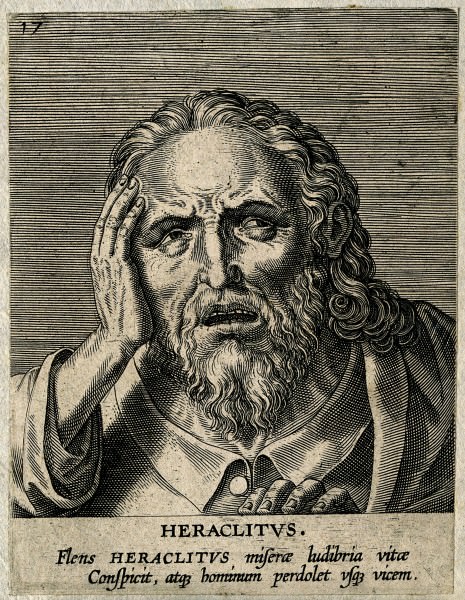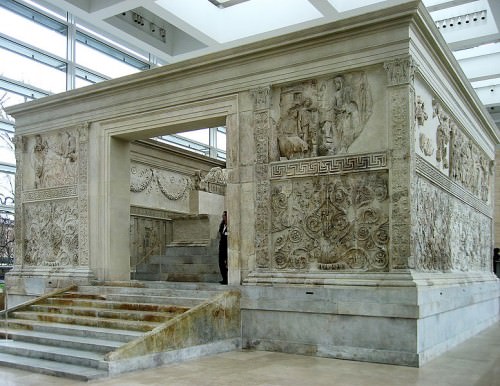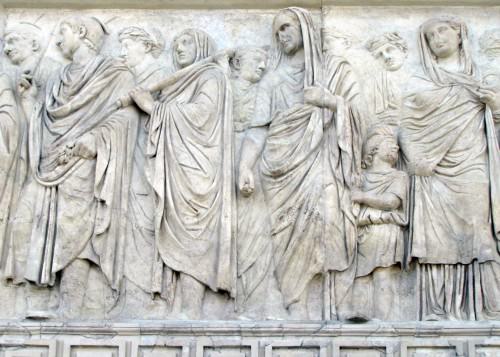Heraclitus of Ephesus › Ara Pacis Augustae » Ancient origins
Articles and Definitions › Contents
- Heraclitus of Ephesus › Who Was
- Ara Pacis Augustae › Antique Origins
Ancient civilizations › Historical and archaeological sites
Heraclitus of Ephesus › Who Was
Definition and Origins

Heraclitus of Ephesus (c. 500 BCE) was known to his contemporaries as the 'dark' philosopher, so-called because his writings were so difficult to understand. Seeming to hold the common understanding of the nature of life and the purpose of human life in contempt (as, in fact, he seemed to hold most, if not all, the human beings he came in contact with) Heraclitus compared most people's understanding to that of those asleep. To Heraclitus, only the philosopher, the one who pursued Truth, was fully awake and fully alive, and he seemed to consider himself the only philosopher of his time.
PROVOCATION & OBSCURITY
His writings, which so confounded the many, seem purposefully written to force a reader toward independent thought and realization (much like the Zen Koans of the east) instead of providing them with more of the same sleep-inducing 'philosophies' of life Heraclitus so despised. Scorning the fairly straight forward approach of his predeccesors, such as Anaximander, Anaximenes, and Xenophanes, he consistently insisted on a determined obfuscation of his meaning. While this is generally understood as an attempt to enlighten his readers it could as easily be interpreted as simply a reflection of his individual character as it is reported by ancient writers that he brought about his own death by speaking to the doctors in this same willfully confusing manner.
LIFE IS FLUX
Following in the traditions of the earlier Pre-Socratic philosophers, Heraclitus expounded a physical theory of matter and the physical world much along the lines of Thales, Anaximander and Anaximenes, but took the ideas further in his famous assertion that “Life is Flux” ( Panta Rhei in Greek, meaning everything or all things change). If one understands that change is the only constant in life then one will more easily recognize what Heraclitus is saying in his 'obscure' writings when he claims such things as, “The way up and the way down are one and the same. Living and dead, waking and sleeping, young and old, are the same.” These things are the 'same' in that they are all subject to change, arise from one change to vanish into another and all things, constantly, are in flux and are, in that regard, the same.
HERACLITUS MADE THE ASSERTION THAT “LIFE IS FLUX” (PANTA RHEI IN GREEK, MEANING EVERYTHING OR ALL THINGS CHANGE).
Heraclitus was famous among his contemporaries for his undisguised contempt for all of them and, equally, those who preceeded them. Among the over 100 fragments we have of his work is this one which claims, "A knowledge of many things does not teach one to have intelligence; otherwise it would have taught Hesiod and Pythagoras or, again, Xenophanes and Hecataeus" (DK 22B40). Commenting on this, Professor JM Robinson writes, "To know many things - to know the causes of thunder and lightning and earthquakes - is good; but it is better to understand the one thing which underlies all of these - the thought that steers all things through all things. This is wisdom" (Robinson, 88). The underlying form of life, the `wisdom' Heraclitus understood, is that the human condition is chiefly characterized by strife, by the coming together and pulling away of opposing forces. While people lament this strife, equating it with suffering, Heraclitus observed that this same process informed the natural world as well writing, "All things come into being through opposition and all are in flux like a river" (DK 22A1). There is no reason, then, to fear or try to avoid strife because conflict is the essential underlying force in life.
HERACLITUS' WORLD ORDER - LOGOS
This contending of forces, which Heraclitus characterized as fire, is easily observable in nature and yet human beings resist the natural movement of life and try to cling to what is known and what is considered safe. Heracitus claimed that this `clinging' is unnatural and is what causes people to suffer. He writes, "This world order, the same for all, no god made or any man, but it always was and is and will be an ever-living fire, kindling by measure and going out by measure" (DK22B30). The world order is continual change and resistance to this change is a kind of death in that the individual is refusing to participate in that which defines life. Though it seems he would never admit to it, Heraclitus appears to have developed the concepts of Xenophanes concerning a single, eternal `God' who is behind all things and who set all in motion; he called this force the Logos.

Heraclitus of Ephesus
In Greek, Logos means `the word' but also means `to speak' and can also refer to `conveying thought' and the Logos of Heraclitus may most neatly fit the latter meaning. The Logos constantly `conveys thought' to human beings but the message is missed because of the consistent refusal of people to recognize the natural order in their own lives. Heraclitus writes,
Though the logos is as I have said, men always fail to comprehend it, both before they hear it and when they hear it for the first time. For though all things come into being in accordance with this logos, they seem like men without experiences, though in fact they do have experience both of words and deeds such as I have set forth, distinguishing each thing in accordance with its nature and declaring what it is. But other men are as unaware of what they do when awake as they are when they are asleep. (DK 22B1)
The Logos is rational, natural, universal `thought' through which the universe came into being and by which it is maintained.
In this respect, Heraclitus' beliefs correspond with those of the younger philosopher Parmenides, who claimed that all of existence was One, was of the same exact substance, and could never be created or destroyed. Heraclitus' Logos would correspond to Parmenides' One with the distinction that the Logos informs all things but is not those things themselves.Parmenides' disagreed with Heraclitus' claim that all was strife and the eternal clash of forces, insisting that all such observations were based upon false sensory interpretation. Heraclitus, however, would argue that Parmenides' argument was flawed in that the operation of the Logos is simply the natural order of life and an understanding of it is not dependent on the senses but on reason. He writes, "They do not comprehend how, though [the Logos ] is at variance with itself, it agrees with itself. It is a harmony of opposed tensions, as in the bow and the lyre " (DK22B51) and, further, "In opposition there is agreement, between unlikes, the fairest harmony" (DK22B8) and, "The hidden harmony is stronger than the apparent" (DK22B54). This `hidden harmony' is the basic `stuff' of existence which, when properly apprehended, makes life both sensible and meaningful. The later philosopher, Zeno of Citium, would develop this idea into the school of thought known as Stoic Philosophy which would further be developed by the Stoic philosopher Epictetus, among others, to become the dominant strain of philosophical thought in Rome.
DEATH
Diogenis Laertius (c. 200 CE), in the 8th book of his famous Lives and Opinions of Eminent Philosophers relates the death of Heraclitus and how it was in keeping with his life:
When somebody asked Heraclitus to decree some rules, he showed no interest because the government of the city was already bad. Instead, he went to the temple of Artemis and played dice with children. Finally he became misanthrope, withdrew from the world and lived in the mountains feeding on grasses and plants.However, having fallen in this way into dropsy he came down to town and asked the doctors in a riddle if they could make a drought out of rainy weather. When they did not understand he buried himself in a cow-stall, expecting that the dropsy would be evaporated by the heat of the manure; but even so he failed to effect anything, and ended his life at the age of sixty.
The `dropsy' Heraclitus suffered from would, today, be known as `edema' a swelling of soft tissue due to an accumulation of fluid beneath the skin. It was typical of Heraclitus to pose his problem to the doctors in a riddle as it seemed he was always testing others in the belief that he possessed above-average intelligence. When they failed to understand his request that they `make a drought out of rainy weather' to mean he was suffering from dropsy, he, also typically, decided he knew best how to cure himself.
Scholars place his death at about 475 BCE. Besides the Stoic school, Heraclitus' thought would greatly influence others who came after him and his riddles are often quoted and alluded to in Plato 's Dialogues and, later, in the works of Aristotle. He has consistently been cited as among the most brilliant, if difficult, of the Pre-Socratic philosophers and his importance in synthesizing the human experience with the natural world continues to be recognized today.
Note: The `DK' citations refer to the Diels-Krantz catalogue of Fragments of the Pre-Socratic Philosophers as used in Kathleen Freeman's Ancilla to the Pre-Socratic Philosophers.
Ara Pacis Augustae › Antique Origins
Ancient Civilizations
The Ara Pacis Augustae or Altar of the Augustan Peace in Rome was built to celebrate the return of Augustus in 13 BCE from his campaigns in Spain and Gaul. The marble structure, which once stood on the Campus Martius, is a masterpiece of Roman sculpture and, in particular, of portraiture. Senators, officials and the Imperial family are depicted on the wall reliefs of the monument in an animated procession, perhaps, the very procession which consecrated the altar site on 4th July 13 BCE or the celebratory procession to welcome the emperor's return.

Ara Pacis Augustae
Voted for by the Senate in 13 BCE the monument was completed within four years using Italian Luna marble and dedicated on 30th January 9 BCE. The structure has a central altar set on a podium surrounded by high walls (11.6 x 10.6 m) composed of large rectangular slabs. There are two entrances, one on the east and the other on the west (back) side, the latter having a short flight of steps due to the lower ground elevation on that side in its original position.
THE 3 M TALL ALTAR ITSELF STANDS ON A 6 X 7 M PODIUM & HAS RELIEF SCENES DEPICTING VESTAL VIRGINS, PRIESTS & SACRIFICIAL ANIMALS.
The 3 m tall altar itself stands on a 6 x 7 m podium and has relief scenes depicting Vestal Virgins, priests and sacrificial animals. The interior sculpture of the surrounding walls depicts fruit and flower garlands hanging from ox heads (bucrania) above fluting. The lower portion of the exterior walls has richly sculpted acanthus scrolls whilst the upper portions carry relief figures. The cornice of the surrounding wall is a modern addition and is, therefore, plain whereas the original cornice would have been highly decorative with palmettes at each corner. The whole structure, including the reliefs, would have been richly painted and have had touches of gilding.

South Side, Ara Pacis
On the east and west sides of the exterior walls are panels with mythological scenes including a version of the she-wolf nursing Romulus and Remus, Roma seated on a pile of armour flanked by Honos and Virtus, Aeneas sacrificing to the Penates and a female figure with two children who may be Pax, Venus Genetrix or Tellus (Mother Earth).
The relief figures on the north and south exterior walls are arranged in two groups. On the south side are Augustus and the Imperial family. On the north side are officials such as magistrates, senators, priests and their families. All are captured in a single moment as they participate in a procession. Some figures are speaking to each other, one figure (possibly Augustus' sister) holds a finger to her lips and calls for silence whilst elsewhere some children look decidedly bored with one small child pulling the toga of an adult in order to be picked up. The animation and individuality of the figures is a high point of Romansculpture and the relief is also graded to give the scene depth and a further reality.

Procession Relief, Ara Pacis
Interestingly, although Augustus is present in the scene, the emperor is actually not so easy to pick out, which is in great contrast to later Imperial sculpture where the emperor of the time is very much the focal point of the monument. As Charles Wheeler stated, 'If we would understand the Augustan period - its quiet good manners and its undemonstrative confidence - in a single document, that document is the Ara Pacis Augustae.'
The altar came to represent Pax (Peace), a concept particularly forwarded during the reign of Augustus and it was probably for this reason that the Ara Pacis appeared on the coins of Nero between 64 and 67 CE. Various pieces of the altar were re-discovered c. 1568, 1859 and 1903 CE and a more concerted excavation of the site was carried out between 1937 and 1938 CE. The hundreds of altar fragments, which had been dispersed across several European museums, were collected together and the altar reassembled. Largely complete, the altar now stands in the purpose built Museo dell'Ara Pacis, an elegant glass and stone structure next to the Mausoleum of Augustus in Rome.
LICENSE:
Article based on information obtained from these sources:with permission from the Website Ancient History Encyclopedia
Content is available under License Creative Commons: Attribution-NonCommercial-ShareAlike 3.0 Unported. CC-BY-NC-SA License